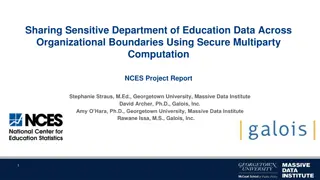Effectiveness of Household Leaders in Improving Malaria Chemoprevention Adherence in Cameroon
The EHLIAN project in Cameroon aims to assess the impact of utilizing Household Leaders to enhance adherence to seasonal malaria chemoprevention in the Far North region. The study compares reminder strategies for adherence to SPAQ courses, evaluates community outcomes, and explores the feasibility of the intervention. Various arms, treatment modalities, and delivery strategies are utilized in different health areas to achieve the project objectives.
Download Presentation

Please find below an Image/Link to download the presentation.
The content on the website is provided AS IS for your information and personal use only. It may not be sold, licensed, or shared on other websites without obtaining consent from the author.If you encounter any issues during the download, it is possible that the publisher has removed the file from their server.
You are allowed to download the files provided on this website for personal or commercial use, subject to the condition that they are used lawfully. All files are the property of their respective owners.
The content on the website is provided AS IS for your information and personal use only. It may not be sold, licensed, or shared on other websites without obtaining consent from the author.
E N D
Presentation Transcript
Effectiveness of using Household Leaders (HL) to Improve Adherence and Impact of Seasonal Malaria Chemoprevention in Northern Cameroon (EHLIAN). Cameroon OPT-SMC Project Preliminary report February 21, 2023 Dr BOMBA Dominique PNLP Cameroon
Research Questions What is the effect of reminders by Household Leaders on adherence to SPAQ for dose 2 and dose 3 by caregivers in SMC in Cameroon? in terms of overall coverage? adherence to SPAQ dose 2 and dose 3? community parasite carriage? acceptable and feasible?
Objectives Determine the effectiveness of two reminder strategies on adherence to SPAQ course in Far North region of Cameroon. In terms of coverage, adherence and parasite outcomes Evaluate the acceptability and feasibility of the neighbourhood leader reminder strategy compared to the standard SMC delivery strategy and DOT by drug distributors
Study design Arm 1 Arm 3 Arm 2 Treatment 1, Mobiliser- Distributors (DOT on all 3 days) Treatment 3 SoC Treatment 2 Household Leaders 1. Household Leaders: Experience with SMC (given 2 hours training) 2. Respected Men and Women in the community 3. Selected by head of health centre and CHWs, representative of neighbourhoods 4. Willing to remind in 5-6 houses around their home.
Delivery strategies by health areas/Arm Modality Intervention Arm 1/ Kaele n=1050 enfants Intervention Arm 2/ Mapoussere n=1050 enfants SoC Arm 3/ Garey n=1050 enfants Mobilisation by town crier SPAQ admin by parent/caregiver DOT D 1 dose by drug distributor (DD) or CHWs Return D2 and D3 by drug distributors 20 DD selected by IHC chief Visit D2 and D3 by Neighbourhood member 120 household leaders Trained for 2.5hrs Were not remunerated
Methodology Study component 1800 target households(3000 children) total in three health areas Adherence Adherence questionnaire administration, 1.2 days after dose 3 of SPAQ Baseline(BL) and End of Round(EoR) Parasite Survey 1780, 2200(BL vs EoR) target children,and 1000 non-target children(EoR) in three health areas Malaria mRDT, questionnaire, microscopy, DBS Bednet Coverage etc. 600 target children, 200 per health area Parasite free (RDT-, Microscopy -ve) at cycle 1. Parasite clearance study Surveys 3 weeks after dose 3 for all cycles. Conducted by CHW in health areas.
Baseline Coverage on day 1 Definition: % of target children that received the first dose in each area with proof by health area(intervention arms). Arm 1: Kaele DOT by drug distributors Arm2: Mapoussere neighbour hood leaders Arm 3: Garey - standard 100. 75. 50. Mapoussere (arm 2) vs Garey (arm 3): 0.835 (0.81-0.85) vs 0.93(0.91-0.95) P<0.0001 25. 0. Cycle 1 Cycle 2 Cycle 3 Cycle 4 Aggregate Kaele (arm 1) vs Garey (arm3): 0.84 (.082-0.86) vs 0.93(0.91-0.95) P<0.0001 Kaele Mapoussere Garey Trend towards reduction in coverage of intervention. Significantly lower coverage in intervention areas vs Standard of Care
Adherence to SPAQ Definition: % of children adhering fully to day 2 and 3 doses of SPAQ with proof by health area(intervention arms). 1. Arm 1: Kaele DOT by drug distributors Arm2: Mapoussere neighbour hood leaders Arm 3: Garey - standard 0.75 0.5 0.25 0. Cycle 1 Cycle 2 Cycle 3 Cycle 4 Aggregate Kaele Mapoussere Garey Reduction in the proportion of children adhering to 2nd and 3rd dose by SMC cycle. Generally higher in standard of care compared to intervention areas.
Proportion of Dose 2 and 3 reminders, timing and gender of person Reminder D2 Reminder D3 Timing of D2/D3 Reminder(A.M) Gender 98% 75% 50% 93% 33% 75% 22% 55% 25% 25% 2% 6% 0% Kaele DD/CHW Others Mapoussere HL Others Garey Others Men/Women 1. Reminder by household leader at 75% in Mapoussere. 2. Reminder visits in morning at Mapoussere and Kaele and evenly split in Garey(50% AM, 50% PM) 3. Men and women reminded alike, in almost equal proportions
Results 2: Community parasite carriage by intervention strategy. Target Children Non-Target Children Baseline EoR p=0.9279 50.00% 46.6% 46.30% 50.00% p<0.0001 46.30% p<0.0001 36.1% 37.50% p=0.0001 37.50% p=0.0019 26.68% 25.00% 21.75% p=0.054 25.00% 21.75% 17.0% 11.63% 12.50% 9.64% 9.64% 12.50% 6.48% 0.00% 0.00% Kaele Mapoussere Garey Kaele Mapoussere Garey 1.Baseline Prevalence in Mapoussere high: indicate transmission peaking before start of cycle 1. 2.87% Proportionate increase in parasitemia in Garey (EoR). 3.47.5% proportionate increase in Kaele (EoR). 4.74% proportionate increase in Mapoussere (EoR).
Preliminary Conclusions 1.Primary outcome: ADHERENCE Aggregate adherence to dose 2 and 3 is high, but much higher in control region than in intervention regions(household leaders). Aggregate Adherence falls from cycle 1-4 uniformly, but remained above 50%, consistent with trend in performance and coverage Effect of adherence on SMC indicators likely masked by a) specificity of malaria transmission pattern in intervention area, management practice in intervention area and possible role of ethnic customs. Results are thus preliminary and early pointers that need adjustments in ongoing statistical analysis.
Preliminary Conclusions 2 2. Primary outcome: EFFECTIVENESS-COMMUNITY PARASITE PREVALENCE Higher baseline and EoR parasite prevalence in Mapoussere indicating ongoing transmission at least one month prior to stat of SMC cycle 1 extending to November, one month after end. Clear shift in burden of malaria to non-target children 5-14 years, more than 70% proportionate increase in Kaele and Garey, but not Mapoussere. Analysis of data is still ongoing and will shed light into the role of interventions in parasite carriage.
Recommendations Use of Household leader is feasible(75% households for D2 and D3) as an adherence improvement strategy. Consider start SMC cycle 1 in early (June), to reduce the burden of malaria. Importance of fine scale analysis of all regions to select eligible regions and start times for better impact. Consider extending SMC to children over 5 years in future. Qualitative aspects of the study (planned) should clarify the reasons for some of the observations in quantitative study.
Acknowledgements Funders: EDCTP via OPT-SMC Univ. Thies, Senegal NMCP Partners in SMC. PMI, USAID, Cameroon Measure Malaria Impact Malaria WHO, Cameroon Office The Biotechnology Centre, Univ Yaounde 1 MINSANTE, Cameroon






















